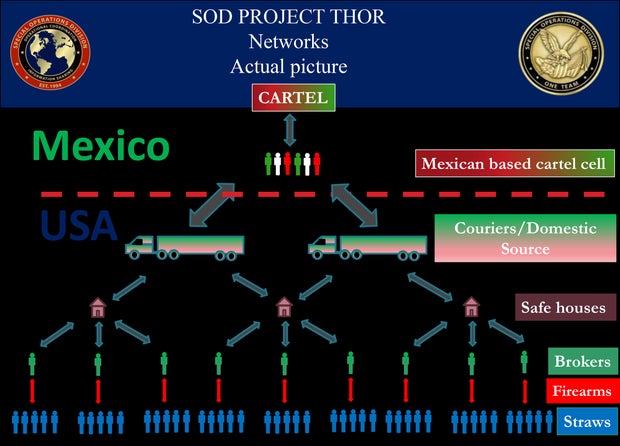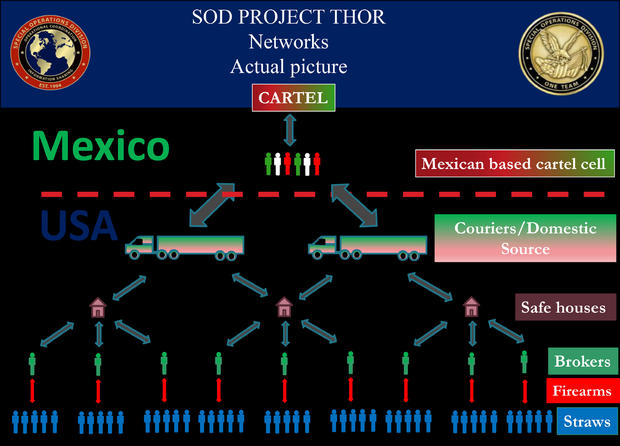Watch the CBS Reports documentary “Arming Cartels: Inside the Mexican-American Gunrunning Networks” in the video player above.
Mexican drug cartels have been smuggling a vast arsenal of even military-grade weapons out of the U.S. with the help of American citizens, a CBS Reports investigation has found.
Exclusively-obtained U.S. intelligence documents and interviews with half a dozen current and former officials reveal that the American government has known this for years but, sources said, it’s done little to stop these weapons trafficking networks inside the United States, which move up to a million firearms across the border annually, including belt-fed miniguns and grenade launchers.
Dozens of cartel gunrunning networks, operating like terrorist cells, pay Americans to buy weapons from gun stores and online dealers all across the country, as far north as Wisconsin and even Alaska, according to U.S. intelligence sources. The firearms are then shipped across the southwest border through a chain of brokers and couriers.

Project Thor / Obtained by CBS News
When
For more than 50 years, the U.S. government has waged an unsuccessful war on drug traffickers, who are now fueling a deadly fentanyl epidemic. The free flow of American guns across the southern border empowers the cartels to protect their drug operations and outgun Mexican authorities, U.S. officials said.
“We have allowed the cartels to amass an army,” said Chris Demlein, who served as a senior special agent with the Bureau of Alcohol, Tobacco, Firearms and Explosives — the ATF — until 2021.

U.S. government photo
Demlein led the first interagency intelligence project aimed at identifying and dismantling the cartels’ international weapons supply chains across the U.S. Within months of its launch on July 25, 2018, the initiative, known as Project Thor, connected the dots between hundreds of disparate law enforcement cases, uncovering vast networks that give these criminal groups on-demand access to American guns. They briefed hundreds of government officials on their discoveries, including the National Security Council and senior Justice Department leadership.

CBS News
Project Thor found that the problem of cartel weapons smuggling was far worse than previously understood. They estimated that cartels were trafficking between 250,000 and 1 million weapons every year, with a retail value of up to $500 million, not including ammunition and tactical supplies, according to intelligence analysis reviewed by CBS News.
Project Thor concluded that American guns were being used to fuel an unprecedented spike in violence across Mexico. Up to 85% of firearms found at those crime scenes traced back to the U.S.
Without Project Thor, U.S. law enforcement “bureaucracies were more interested in defending their turf than prosecuting criminal organizations,” said Edwin Starr, who retired from the ATF as a senior special agent in December 2022. Starr credited the interagency program with leading to a major breakthrough in one of his firearms trafficking cases that, according to Demlein, helped take down an entire cartel gunrunning network.
On Dec. 8, 2021, ATF chief of staff Daniel Board praised Project Thor’s “insight, initiative and hard work” as he presented the team with the agency’s Distinguished Service Medal.
But Project Thor was denied funding for fiscal year 2022, according to internal documents and sources with direct knowledge, effectively shutting it down. The Justice Department and ATF would not disclose how much money is dedicated to the mission of countering international firearms trafficking to Mexico.
Over the course of four months in 2023, CBS News
The Biden administration signaled a new commitment to tackle the issue at a June 14 press conference, pointing to the ATF’s Operation Southbound, an investigative and prosecutorial “nationwide initiative” designed to “disrupt the trafficking of firearms from the U.S. to Mexico” focused on border states. Officials also pointed to funding for gun tracing and ongoing diplomatic efforts to train and equip Mexican law enforcement with that technology.
However, other law enforcement, intelligence and diplomatic officials told CBS News they doubt their own agencies’ commitment to dismantling cartel gunrunning networks across the U.S., and criticized the ongoing approaches as “ineffective.”
“Any U.S. strategy that depends, for its success, on Mexican law enforcement efforts in Mexico is doomed to failure,” warned Christopher Landau, who served as U.S. Ambassador to Mexico until 2021. “We’ve been talking about this for 10, 20 years. Nothing is changing. … This has been a major bipartisan failure of the U.S. government for many decades.”
Senior officials defended their approach to countering weapons smuggling out of the country.
“ATF is committed to stopping as many guns as possible from being illegally trafficked into Mexico,” ATF Director Steven Dettelbach told CBS News in a statement, touting the prosecution of 100 people in the past year. “Investigating straw purchasers is just one tool that we use. Our efforts also include large scale, long term, complex investigations of entire trafficking networks.”
Neither the Justice Department nor ATF provided evidence to demonstrate that their efforts have meaningfully reduced the flow of American firearms to Mexico. U.S. law enforcement seized 1,720 firearms in the first six months of fiscal year 2022. According to Deputy Attorney General Lisa Monaco, speaking at a news conference in June, “that’s a more than 65% increase over the same period last year.” But it accounts for less than 1% of all firearms being smuggled across the border, based on estimates by Project Thor and the Mexican government.
-Adam Yamaguchi and Sarah Metz contributed reporting.
